 |
|
 |
2023
May
29
|
M101 with supernova
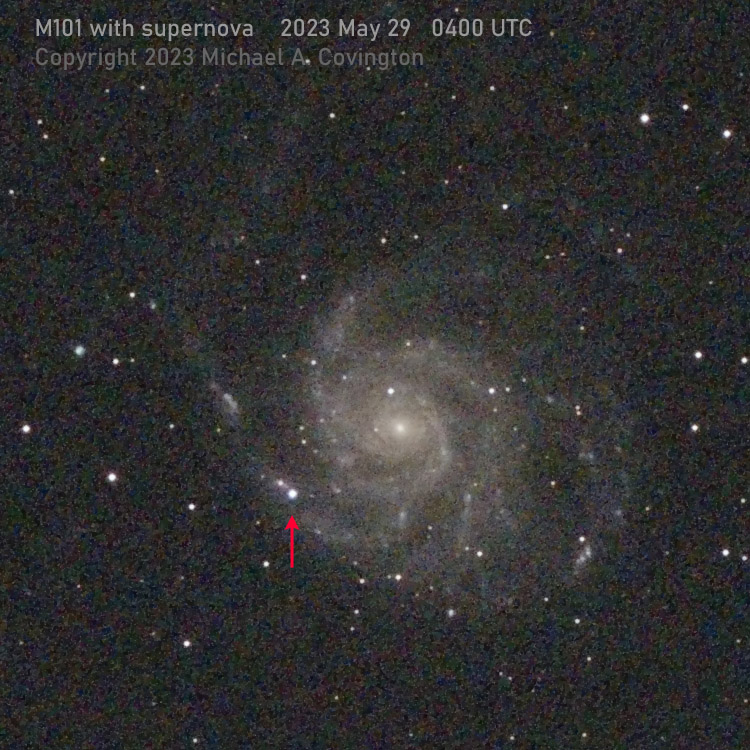
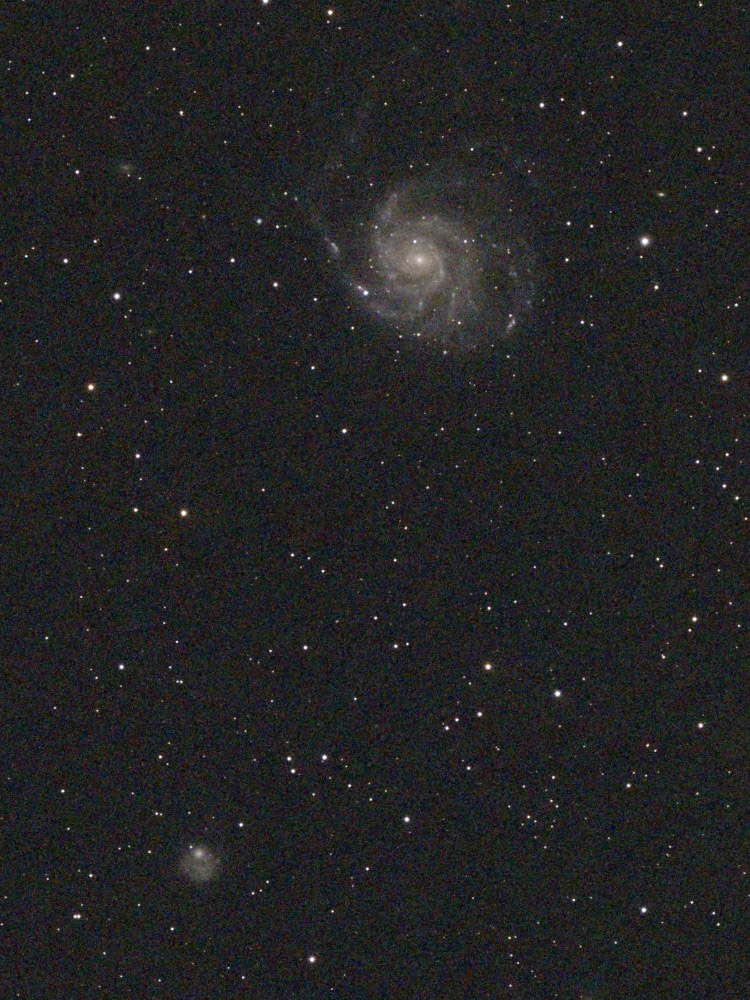
I've finally gotten a picture of the supernova in M101 that has been shining for several days.
It is apparently slow-paced and brighter than the entire rest of the galaxy, so if you want
to see a supernova visually with a 6-inch or larger telescope, now is a good time to try.
M101 is near Mizar in Ursa Major, but you'll need a map to find the galaxy and the 11th-magnitude
supernova.
It's a good time if your weather is better than mine! For this picture I was dodging high, thin
clouds, the moon was high in the sky, I was using an excessively small telescope set up in haste,
and I had a couple of guiding problems due, I think, to dragging cables.
Nonetheless, I got 22 good 2-minute exposures through the AT65EDQ refractor
(6.5 cm, f/6.5) with the Canon 60Da camera at ISO 640.
These two pictures are crops of the same image. In the wider-field version, you can also
see the galaxies NGC 5474 at the bottom and NGC 5477 at the upper left.
Permanent link to this entry
AT65EDQ moon
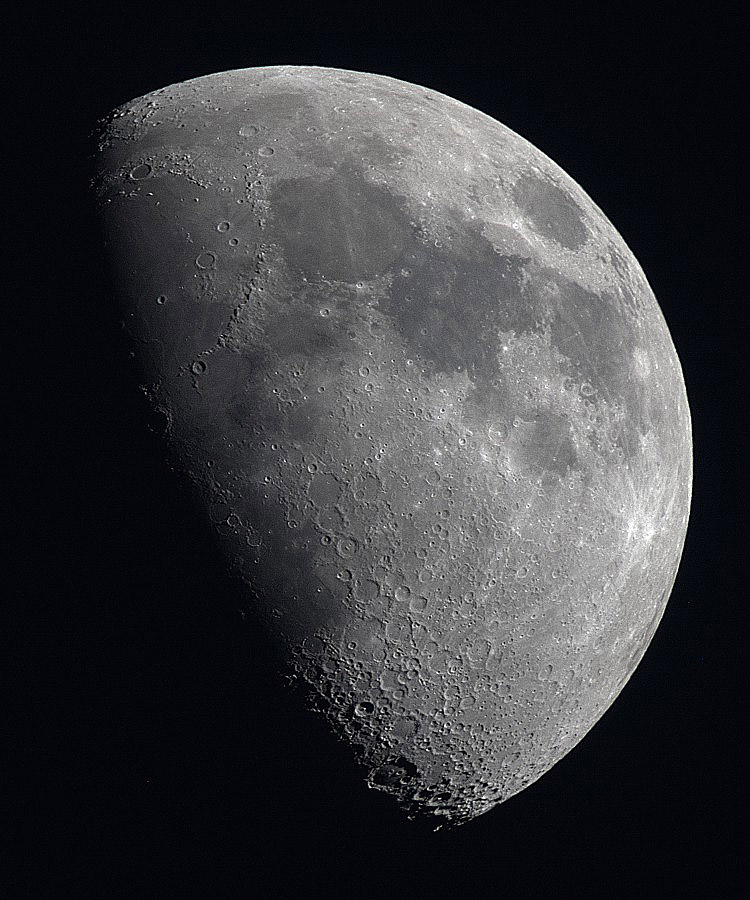
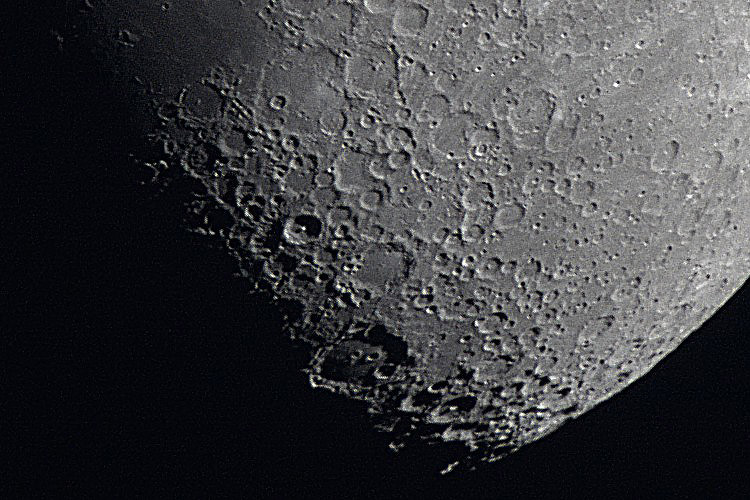
These are two crops of the same image.
My other project last night was to see how well I can use the AT65EDQ to take full-face
moon images, combining it with a Tamron 2× teleconverter (giving f/13),
still using the Canon 60Da, this time at ISO 400.
This is a stack of five 1/160-second exposures,
deBayered at full resolution with PIPP, stacked with AutoStakkert,
and sharpened and adjusted in PixInsight and Photoshop.
Permanent link to this entry


|
2023
May
27
|
Sunspots
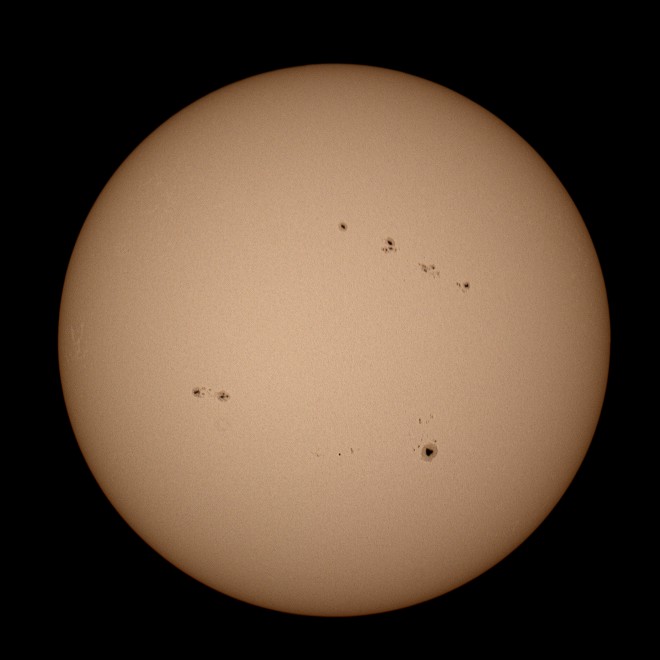
One of the perks of working at home is that I can take a break, go outside, set up a telescope,
and come back with a picture like this.
This is what I did before lunch on Thursday (May 25). Stack of five still pictures taken with my
Canon 60Da and vintage Celestron 5 (f/10) with a Thousand Oaks solar filter,
deBayered with PIPP, stacked with AutoStakkert, and sharpened and adjusted in PixInsight.
Permanent link to this entry


|
2023
May
24
|
Super Glue doesn't keep — these are better
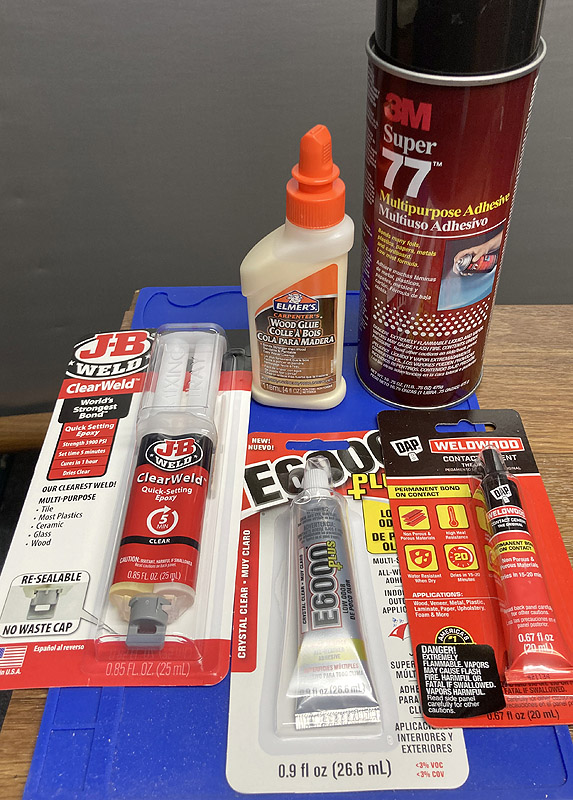
I found out the hard way that several of the glues in my workshop
(Dap Rapid Fuse, Gorilla Super Glue Gel, and original Super Glue)
had gone completely bad. (They looked the same as ever, but simply
wouldn't stick!) Some others had started to dry out, so I restocked.
I also read up on the subject a bit.
Key lesson: Cyanoacrylate (Super Glue) has a very short shelf life,
and quite a few newer glues use it,
even if they aren't billed as Super Glue or instant-bonding.
And glues of this type can have a useful life as short as just a couple of days
after opening! And just one year if unopened.
One premium brand does claim 20 months if the glue is stored
in the refrigerator.
So from now on I will steer clear of new-style glues that claim high
performance and are a little vague about how they work.
And I will buy Super Glue, when needed, on the day I'm going to use it.
By the way, my way of testing Super Glue involves gluing together the back
(non-sticky) side of electrical tape. If the glue is in good condition, it
bonds instantly. I always have electrical tape available, and it's always
clean and always the same material, so it's good for testing.
The picture shows what I restocked with. These are chosen because they last a relatively
long time, and when they degrade, I can see that they've started to dry up
or thicken. In the picture:
-
Elmer's Carpenter's Wood Glue. For porous surfaces, including paper and
cardboard. Takes hours to dry, but has no odor and is stronger than wood itself.
Shelf life is probably a few years; it does degrade with age.
-
3M spray glue. There are several competitors, including an Elmer's product.
This is ideal for putting labels on packages.
(Turn the label upside down in the trash can, spray the back of it,
and immediately stick it on.)
I originally used it to glue together foam padding in equipment cases.
It's not tremendously strong, but good for materials where other glues would
be hard to spread evenly, and for gluing coatings (cloth, plastic, etc.) onto surfaces.
This can is not from this week's restocking; it is 15 years old and still as good as new.
-
5-minute epoxy. That means 5 minutes until it starts to harden, not 5 minutes
until a full cure. It has to be mixed for use, of course. When stored unmixed and
protected from air, it has an enormous shelf life (I've heard someone claim 25 years).
Very permanent; almost impossible to remove once cured.
-
E6000 Plus. This is one of many glues that consist of plastic dissolved in
a solvent, probably acetone. Useful with a wide variety of materials; medium strength;
fast-drying; removable with acetone. Many other glues (such as Testor's) work similarly.
The shelf life depends on how well you store it, but the important thing is,
when it starts to dry up, you can see it, and if it looks normal, it's usable.
-
Weldwood contact cement. This ought to be more widely used than it is.
I learned about it through the camera repair profession, which uses it to glue down
the artificial leather coverings on metal surfaces.
It sticks to everything and is peelable, which can be an important
attribute in things that are going to be repaired later.
"Contact" refers to the fact that if you let it dry on separate surfaces,
it will bond instantly when they come into contact; but it can also be used like E6000,
and I often do. Removable with lighter fluid.
Not in the picture is the hot-melt glue gun, which I am just learning to use
and need to use more. Its big advantage is quick results (no drying time needed).
Durable but removable with isopropyl alcohol (which unsticks it but does not dissolve it);
meltable with hot air.
Becoming very common in electronic equipment. Not for high temperatures.
[Added May 28:]
Also not in the picture is silicone seal, of which I already had a reasonably
fresh supply. It keeps for years and dries up quite visibly when it starts to go bad.
This isn't exactly glue, but you can use it to stick things together, and, in many cases,
you can cut them apart later. It is good for sealing holes to keep water out.
It remains rubbery when dry.
Also, I said goodbye to an old standard after learning what it was made of.
GC Radio-TV Service Cement is plastic dissolved in toluene.
It came on the market in the 1930s and I saw my father repair speaker cones
with it in the 1960s.
It has long been popular in the electronics industry because it adheres to a wide
variety of materials, including metal.
But I got curious and looked up what kind of plastic GC Service Cement consists of.
Cellulose nitrate! That means it's very flammable even after drying.
Not what you want on an electrical contact that might get hot or spark.
(Duco Cement is also cellulose nitrate.)
I decided that for small speaker repairs and for insulation and mild threadlocking, I'll use
clear nail polish from now on; and E6000 or Testor's for gluing.
They are more modern plastics dissolved in a solvent,
which is flammable, but only until it dries.
Permanent link to this entry


|
2023
May
20
|
I'll say it again
I'll say the obvious: It doesn't make a bit of sense for the government to have a "debt limit" separate from its budget. The place to balance the budget is in the budget.
As a private individual, I'm not allowed to stop paying for things I already bought when I hit a "limit." It doesn't make sense for the government to operate that way either.
A lot of people don't realize the government can't exactly predict its income and expenses. Tax revenue depends on business activity, which fluctuates. Some expenses vary, too, depending on unforeseen events. That is why no budget is ever exact. I think we should aim for a balanced budget, but we won't hit it every time.
I will add that threatening to default on the debt is wrong for the same reason taking hostages is wrong: It harms people against whom one has no grievance. Indeed, the threat is already doing harm by already making the United States a less reliable creditor. People don't like to do business with customers who threaten not to pay their bills.
I know it is traditional to have these debt-limit showdowns as a way to force the two parties to compromise on budget matters. But that doesn't make it right. Any other arbitrary thing would work equally well. I would suggest threatening to shut down the salaries of members of Congress.
Permanent link to this entry


|
2023
May
16
|
Bookstore at North DeKalb Mall
[Revised.]
Let us pause for a moment and remember North DeKalb Mall
(now Lulah Hills, at N. Druid Hills Rd. and U.S. 78 in Decatur, Ga.), which is being
torn down and redeveloped.
Melody lived near it until 1972 and often shopped there with her family.
I lived in Valdosta until 1973 but regularly went there when visiting
cousins in the area. I was, of course, unaware that the amazing Melody Mauldin
was nearby.
We both fondly remember a Gateway Books bookstore, which
(perhaps on the initiative of the local manager) was slanted toward serious
students (I got language vocabulary cards there).
That makes this one of the few places Melody and I both had enjoyed going before we met.
We can also count the Fernbank Science Center,
Stone Mountain Park (where they told us children remarkably little about what those southern "heroes" had fought for),
a couple of malls,
and the big Treasure Island store (similar to what Target stores are like now,
but with more specialized goods)
on Memorial Drive. (I remember seeing Eicocraft electronic kits there; that's a specialized
item by any criterion.)
What about people? Was there any person at all that we had both met before we met each other?
(Not counting, possibly, college recruiters or interviewers for GHP.)
Sadly, the only one we can identify is the politician Lester Maddox, whom neither
of us had a high opinion of, but he did shake hands with a lot of schoolchildren.
[Added May 20:]
Concerning the end of the mall era, I now see that the original Chick-Fil-A location, at Greenbriar Mall,
is closing; it can hardly do otherwise as the mall declines around it.
I think I may have seen it, on a trip with my Atlanta cousins when the mall was new; I don't think I've
been back since. Or else I saw another Chick-Fil-A in another mall, early on; I remember wondering how
they pronounced it. I didn't eat much Chick-Fil-A until the 1990s, but I like their sandwiches
and their polite employees. Giving employees Sundays off, I think, helps them recruit teenagers who
want to have a life, not just work whenever called in, and this probably gets them higher-achieving
people.
[Added May 28:]
One more observation. When I look at the directory of a still-thriving mall (Mall of Georgia), I find
that the variety of stores has narrowed; it's almost nothing but clothing, especially women's clothing.
Of course malls have always been strongly slanted that way (one of California's classic malls calls
itself Santa Anita Fashion Park), but there seems to be less than ever of everything else.
Bookstores do hang on (the shrinking Barnes & Noble chain only), but hobby shops, record/CD stores,
and Radio Shacks are gone, each for their own reasons. More specialized shopping has moved to
external buildings, often surrounding the mall rather than in it.
Clothing is the one thing people still need to buy locally, rather than online, especially if it's
not closely similar to something they already have, because one has to see it, handle it, and try it on.
Permanent link to this entry


|
2023
May
14
(Extra)
|
Nikon vs. Canon vs. Nikon — I wasn't crazy!
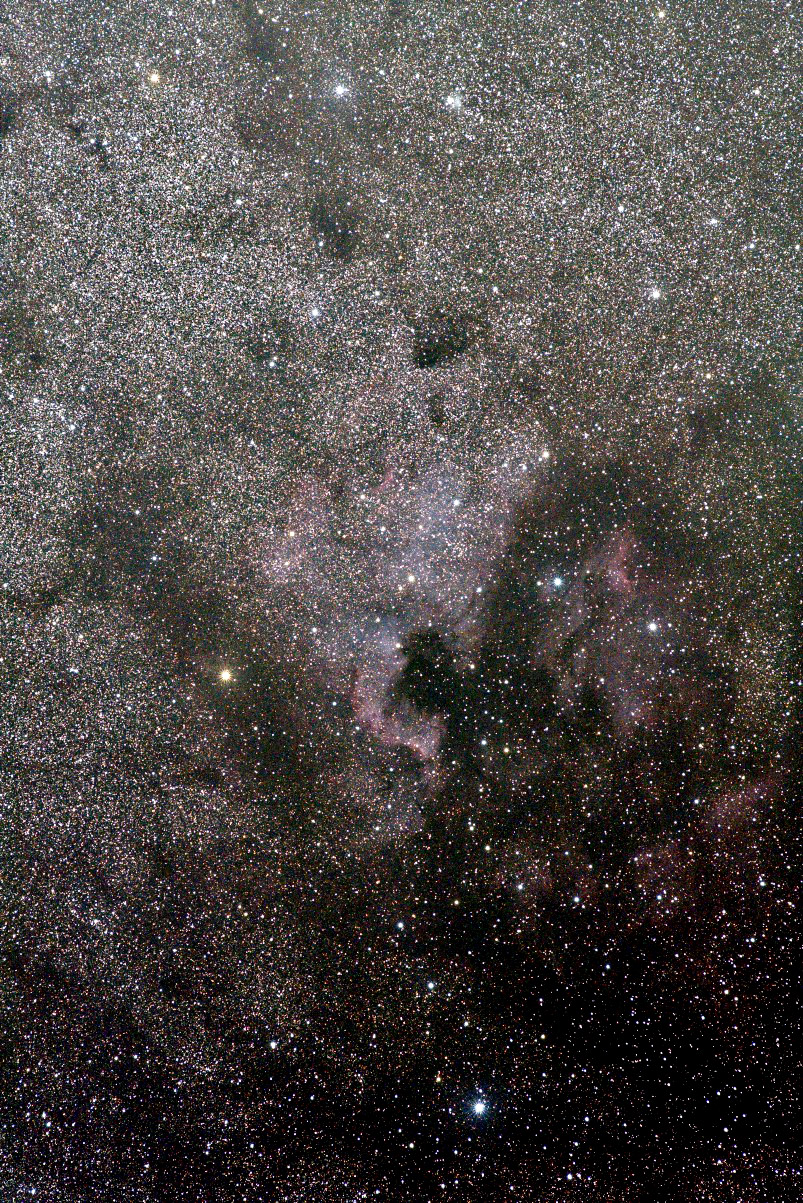
Unmodified Nikon D5300, Nikon 180/2.8 lens at f/4, 8 × 93 seconds at ISO 200.
There is nothing conspicuously wrong with this 2018 picture of the North America Nebula,
despite the notorious
Nikon concentric ring problem
that has been discovered on most Nikon DSLRs.
How did I get lucky?
And in particular, was I mistaken when I recommended this camera in
the latest edition of Digital SLR Astrophotography?
I bought it before writing the book and tested it extensively.
Did I go into print with a mistaken recommendation?
I knew about the slightly lossy compression
used in its digital images; that rarely has a visible effect, and, on the D5300, can be mitigated
by keeping the flat frames and sky background below 973 ADU
or by using Mark Shelley's correction software.
In the picture above I mitigated the lossy compression a different way, by
exposing the flats generously (so the lossy compression would have a tiny overall effect)
and slightly varying the position of the light source from flat to flat, so as to slightly
dither the signal amplitude.
What nobody had discovered at the time is that Nikon also applies a
hardcoded correction that
can show up in stretched astrophotos; it is apparently designed to adjust for off-axis peculiarities
of the sensor, and cannot be turned off on most DSLRs.
That hardcoded correction bit me, later, when I used a Nikon D5500.
Why had I not seen it with the D5300?
The truth emerges:
The D5300 does not perform the hardcoded correction when not communicating with an electronic lens.
Confirmation
here
(and thanks to Mark Shelley for those tests of my camera!).
So the hardcoded correction did not happen when I was using the all-mechanical Nikon 180/2.8 lens used in the picture above,
nor with any telescope.
Further testing has revealed that it does happen with a Sigma 105/2.8 DG EX lens (conforming to the Nikon AF-D standard,
hence not able to autofocus on the D5300). But I could presumably prevent it by covering the contacts on the lens mount.
Dear Mr. Nikon: This is a very reasonable choice. Please make all your DSLRs work this way!
Overwhelmingly, when a camera is connected to non-electronic optics, it's on a telescope, microscope, or
other special lens, and the assumptions underlying your correction don't apply.
So what do I plan to do now?
As explored in many of my own
recent tests
and talks and publications by Robin Glover,
there is much less practical difference than I had supposed
between the older, higher-noise sensor in my Canon 60Da
and the better sensor in the Nikon D5300.
The Canon has some advantages in versatility.
What may be retiring from active duty is my astro-modified Nikon D5500, which requires more
precautions than I care to take, given that other cameras that don't require them are ready
at hand.
I have gotten many fine pictures with it. But its hardcoded correction cannot be turned off,
and the only way to mitigate it is to expose more generously, which results in fine images but
does not take advantage of the low-noise sensor. That is, you can't get away with
underexposure on a D5500 quite as well as on a D5300.
Permanent link to this entry
Nikon D5300 histogram decoded and astrophotographic best practices
Here's how to interpret the histogram on the display of the Nikon D5300:
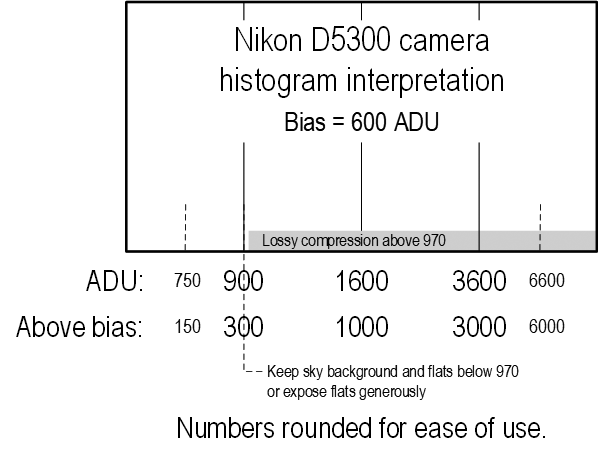
This is the same as the D5500 except that lossy compression starts at 970.
To avoid lossy compression artifacts, keep the sky background and the flats either below 970
or appreciably higher (I have had good results with generously exposed flats). What you don't want
is for either the sky background or the flats to be just a little above 970, resulting in a
discontinuity that can show up when the image is stretched.
To avoid hardcoded correction artifacts (see above),
use optics that do not communicate with the Nikon camera's electronics;
if necessary, cover the contacts when using a Nikon lens
(which deprives you of autofocus, autoexposure, and electronic aperture control).
Permanent link to this entry


|
2023
May
14
|
An iris
The Daily Notebook is not intentionally becoming a Weekly Notebook, but I've been busy!
Hang on while I clear out the inbox...
The way Melody and I do art photography these days is that she "creative-directs" a picture, I take it,
and we are both involved in the selection and editing of the final image.
Here you see an iris in our front yard, making its brief once-a-year appearance.
(Nikon D5300, 18-105 Nikon DX lens. I have set this camera to produce lower-contrast images and
to underexpose a tiny bit, and I'm getting better results. I always do the final adjustment in Photoshop.)

Permanent link to this entry
Fort Yargo
On Friday, Melody and I went on a photo excursion to Fort Yargo State Park, near Winder, which she
and her family frequently visited when she was a teenager. (I went there with her once or twice.)
The focus of the park is one of the oldest buildings in the area, part of an old fort, dating from 1793.
Here's what we came up with. I mostly took pictures on my own while she looked around, but she took the
picture of the bridge, at the end.





All pictures: Copyright 2023 Michael and Melody Covington.
Permanent link to this entry
Inflation confusion
Here's the latest version of my inflation chart, with something added to explain
strange news you're hearing.
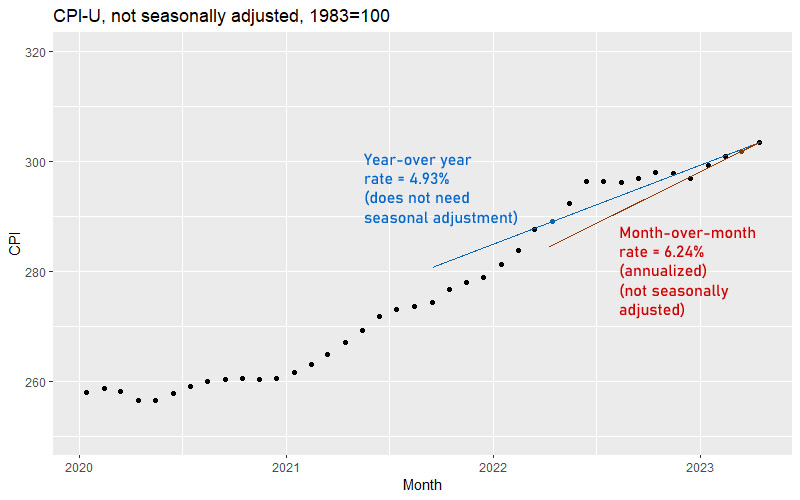
The month-over-month rate is fairly high and relatively constant.
It's the line from the latest dot through the previous (red) one.
But the year-over-year rate is falling fast.
It's the line from the latest dot to the one a year ago (blue).
Look carefully.
The year-over-year rate is not falling because of what's happening now — it's falling
because a year ago we were having a sharp rise.
Two things make the situation better than the graph shows.
First, if it were seasonally adjusted, the month-over-month rate would be lower.
Second, the Producer Price Index (PPI) is, I am told, now showing a considerably
lower inflation rate than the CPI.
Permanent link to this entry
Song of the day
We note the passing of 1970s Canadian folksinger Gordon Lightfoot,
who was performing until just a few months ago.
The first song of his that caught my ear — and perhaps the best of his well-known ones —
was "If You Could Read My Mind," whose opening
strikes me as very creative and well crafted, though later on it turns into a grim song about
a failed relationship. This song came out in 1971 and I remember hearing it in Valdosta.
Permanent link to this entry


|
2023
May
6
|
Milestones
I express my best wishes to all my British friends on the occasion of the
coronation of King Charles III.
If I had had my act together, I'd be showing you a photograph of the star Cor Caroli,
which is named after Charles II.
Meanwhile, as I noted yesterday, the American political wind is shifting rapidly.
People need to be given space to respond to newly emerging facts.
This is not the time for divisive debate.
And we need to remember that facts that have emerged recently were not known to the public in 2016.
Things looked very different then.
I note also that the worldwide and national health emergency for COVID-19 is
coming to an official end, after three years and two months.
COVID is still here but not as common or severe. It's just one more disease we have to be
vaccinated against and occasionally tested for.
But we are not back in the pre-COVID world. We have lost connections with people —
not our closest friends and associates, but rather, many of the familiar faces that we saw
at school, or work, or while shopping, and who were part of our lives, though we did not know
them well enough to seek them out socially. Home delivery of meals and groceries seems to
be here to stay; we simply spend more time at home, or at a few fixed locations, and don't
roam around as much.
Online instruction has partly replaced the University's summer terms;
it will be interesting to see how well-populated UGA is this summer.
I've also noticed that as a result of less roaming around, I feel less of a sense of
geographic location. Melody and I want to counteract this by going on country drives
and simply exploring our own town, which is picturesque. During the plague years,
we didn't go anywhere unnecessarily.
And just as the 1950s polio epidemic gave us better rest rooms and more hand-washing,
I hope some COVID-era improvements in sanitation will remain: we should still
consider it unwise to crowd strangers together, or to go to work or school when one has a cough,
or to require strangers, one after another, to put their fingers on the same buttons or
touchpads.
Permanent link to this entry
Will it fit?
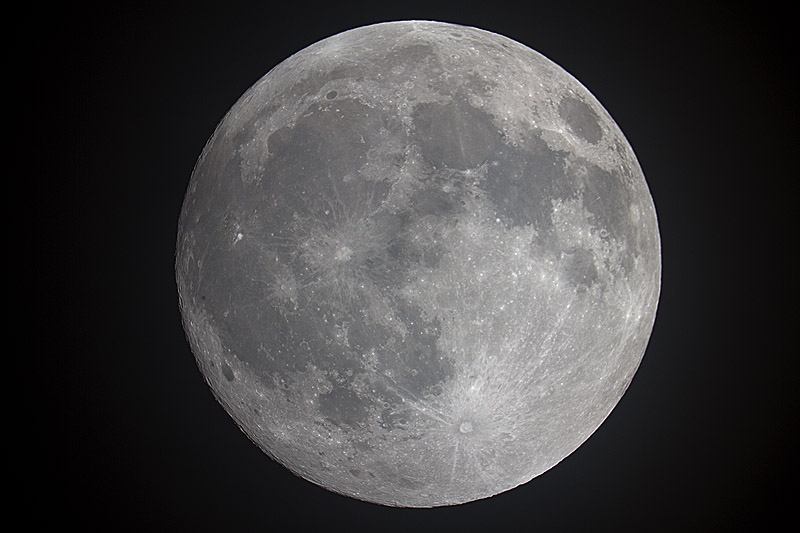
Until recently I had been under the impression that the full face of the moon would not fit
on an APS-C sensor when photographed with the Celestron 8 EdgeHD and ×0.7 reducer.
But as you can see here, it does. This was taken with a Canon 60Da.
In this picture, the moon is at average distance from the earth, giving an apparent diameter
of 31.5 arc-minutes. It can come closer, with an apparent diameter as large as 34.1 arc-minutes,
and in that situation it might not fit in this picture. Here the moon is 3168 pixels across.
The image is 3456×5184 (when decoded the standard way; the sensor has some additional edge
pixels that are accessed by some software).
That means the field is 34.36 arc-minutes high, and 34.1 arc-minutes, the maximum diameter of the moon,
would be a very tight fit. But that situation will arise only when the moon is at perigee
and full, so that I can't leave off part of the unlit portion.
Given Canon's specified pixel size of 4.3 microns, I calculate, also, that the focal length
is 1487 mm, and the image scale is 0.6 arc-seconds per pixel.
Two more things. Just to the right of the top of the picture, you can see a dip in the
limb (visible edge) of the moon. That is Mare Humboldtianum, seen edgewise.
And at the lower left corner, you can see part
of Mare Orientale, enlarged here:
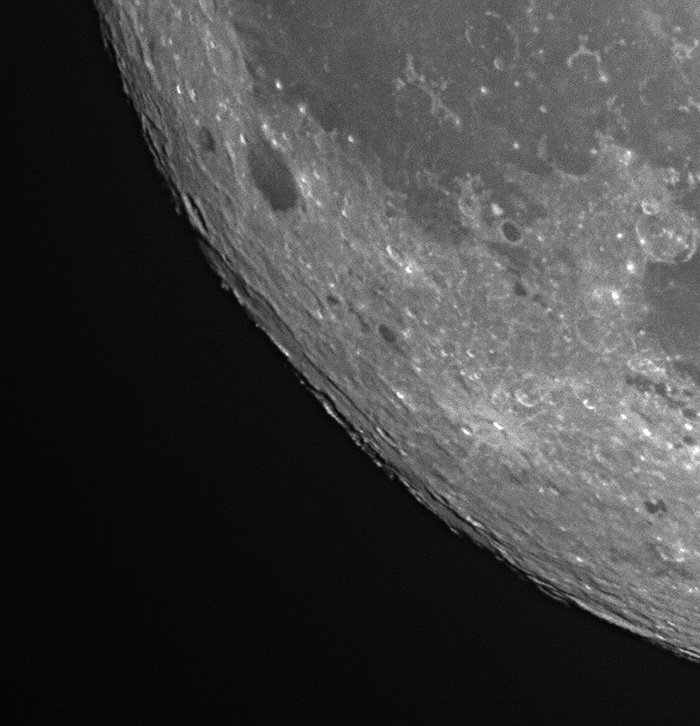
I thank a correspondent for pointing that out.
Permanent link to this entry


|
2023
May
4
|
Time to reconcile
There will be astronomy pictures tomorrow. Today, I have something that emerged
from a conversation with some of my fellow Christians on Facebook. It will interest not
only Christians, but also others who care about moral values in politics and
the life of our nation.
There is a new strain on our national fabric now — as if we had not had enough strain
already — and it requires sensitivity and compassion from all of us.
Now is not the time to tell people how you made the right political choices in recent years.
Now is the time to reach out to people who — intending only good things — have wound up terribly disappointed and angry,
often unsure who to be angry at.
What has happened is that conservative political leadership is collapsing in a new way that most did not foresee.
People are finding out just how dishonestly they had been treated by people who claimed to be standing up for their values,
but were actually playing them for suckers.
Most people who supported Trump, and who trusted Fox News, probably figured there was some risk involved,
but it was still better than the alternative; they wanted to support a flawed voice that upheld
some of their values, rather than support no one.
That is not working out well now. Plenty of people are — if they would admit it — sad and ashamed.
They are likely to feel anger at the bearers of bad news.
It is important not to rub it in.
Good citizenship is about making your country better, not making enemies of your fellow citizens.
If you made choices that came out better, don't be self-righteous.
Remember that there were also drawbacks to voting the way you did.
Many of us felt, in 2016, that neither candidate was satisfactory.
Remember that feeling.
What makes me sad is the lack of a credible conservative wing in our national politics these days,
with positive proposals to solve problems.
If you're not a Democrat, what are you now?
We desperately need some leadership that is right-of-center but realistic and, above all, honest.
Who will provide it?
Unfortunately, many are responding to this situation by getting angry at their fellow citizens,
at the bearers of bad news, or at anyone who got off the bandwagon earlier that they did.
Friendships and families are being torn apart. Pray for our nation, and do your part to
make things better.
Permanent link to this entry


|
| |

|
|
|
This is a private web page,
not hosted or sponsored by the University of Georgia.
Copyright 2023 Michael A. Covington.
Caching by search engines is permitted.
To go to the latest entry every day, bookmark
https://www.covingtoninnovations.com/michael/blog/Default.asp
and if you get the previous month, tell your browser to refresh.
Portrait at top of page by Sharon Covington.
This web site has never collected personal information
and is not affected by GDPR.
Google Ads may use cookies to manage the rotation of ads,
but those cookies are not made available to Covington Innovations.
No personal information is collected or stored by Covington Innovations, and never has been.
This web site is based and served entirely in the United States.
In compliance with U.S. FTC guidelines,
I am glad to point out that unless explicitly
indicated, I do not receive substantial payments, free merchandise, or other remuneration
for reviewing or mentioning products on this web site.
Any remuneration valued at more than about $10 will always be mentioned here,
and in any case my writing about products and dealers is always truthful.
Reviewed
products are usually things I purchased for my own use, or occasionally items
lent to me briefly by manufacturers and described as such.
I am no longer an Amazon Associate, and links to Amazon
no longer pay me a commission for purchases,
even if they still have my code in them.
|
|




















